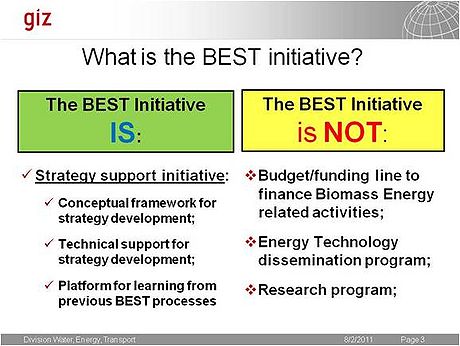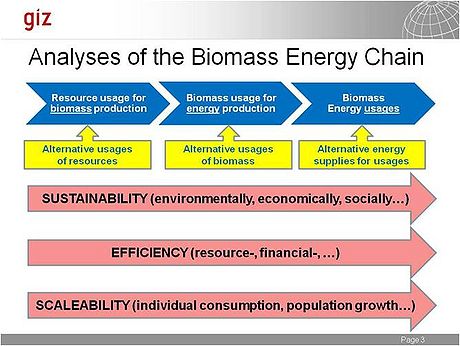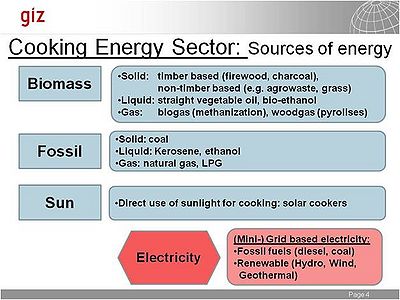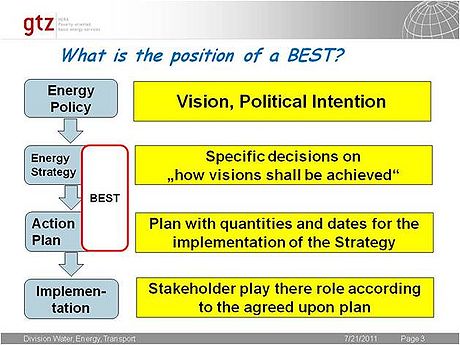Biomass Energy Strategy (BEST)
--> Back to Overview GIZ HERA Cooking Energy Compendium
What is the BEST initiative?
The BEST initiative (coordinated by the GIZ sectoral program HERA and the EUEI PDF) was established to support governments develop national biomass energy strategies. It provides a structured and replicable approach on how to develop comprehensive strategies. The initiative aims at building awareness, in particular among policy decision makers, on biomass energy as the main source of primary energy in Africa and its signifigance in poverty alleviation. EUEI PDF offers concrete funding to provide technical support for the strategy development process.
The core document of the BEST initiative is the BEST Guide. It provides policy-makers, energy planners and consulting companies with an orientation for the development of a national Biomass Energy Strategy (BEST). It defines strategy development as a systematic and ongoing process that follows a consultative and participative approach. The guide is available in English and French.
What is the outcome of the first phase of the BEST initiative?
During the first phase of the BEST initiative, studies have been developed in Botswana, Malawi and Rwanda. These country activities have shown that the development of a strategy is not an easy task to do. At times there are conflicting interests of various important stakeholders to be addressed at any of the stages of the BEST process.
These stages are:
1. Stakeholder analyses and team formation
2. Baseline sector analysis
3. Development of scenarios
4. BEST strategy development
5. Action planning
6. Adoption and implementation
The challenges are as much caused by the complexity of the content as by the complexity of the multi-stakeholder BEST process.
The first two BEST documents have been approved and published by the governments of Botswana and Rwanda . Some selected activities have been implemented in these countries, but they have not been implemented as a comprehensive package within a national program.
Important lessons were learnt in the BEST process of Malawi. While the document has been finalized, it has not (yet) been approved and published by the government. As it turned out towards the end of the process, ministerial partners in Malawi were expecting a "strategy for mainly substituting biomass with modern fuels", rather than a "strategy on how to make the use of biomass energy more sustainable". This turn came to some surprise as the ministry was fully informed about the focus of BEST on sustainable use of Biomass Energy before their application to BEST was written. However, changes in personal in the ministry as well as in the overall political environment triggered a change in the perception of biomass energy at ministry level.
The results of the BEST process were not really accepted by the political decision makers. Though they were involved and given the opportunity to comment at all stages of the process, there was no clear mechanism to ensure that the agreement of the result of one step of the BEST process is the condition for the implementation of the next step of the process. This resulted in a contractual obligation for the continuation of the process despite of a dwindling support by the ministry. For the following BESTs, these lessons learnt have been integrated into the preparation and implementation process by way of strictly defined monitoring and cut-off points to ensure clarity about joint priorities and objectives among the major stakeholders and to ensure that the outcome of the BEST becomes more than just another study.
BEST can have impacts on various levels. The more likely impact is a change in the political debate on the role and the importance of biomass energy for the future of the basic energy supply of major parts of the population. However, as seen in the case of Malawi, these impacts can be undermined by political changes.
As indicated above, the BEST initiative is not financing the implementation of the recommendations which are outlined in the strategy. It is therefore important to involve interested donors to be part of the BEST process in order to enhance their readiness to support the implementation of the action plan later on. However, the presence of a BEST can also be used by governments to guide donors’ interests to support biomass energy initiatives based on the BEST action plan.
What is the content of BEST studies?
The Biomass Energy Chain comprises three elements:
• The production of biomass feedstock for energy generation
• The usage of biomass feedstock for energy production
• The usage of energy produced from biomass feedstock
The past development and current situation of these three steps of the biomass energy chain has to be well understood. However, the chain operates in competition to alternative options which also have to be considered:
• The use of resources to produce biomass feedstock for energy is competing with other possible uses of these resources (e.g. production of food and other biomass products).
• The use of biomass feedstock for energy production competes with other uses of the same biomass feedstock (e.g. wood for furniture production).
• The use of biomass energy (e.g. in households) is in competition with other energy carriers (e.g. LPG).
Along the whole biomass energy chain, the past development, current situation as well as future scenarios have to be analyzed from three perspectives:
a) Sustainability in its environmental, economical and social dimension;
b) Efficiency in respect to resource-usage and economic dimension;
c) Scale ability: is the current set-up suited to accommodate the growth of the individual consumption and/or the increase of population in the foreseen future?
In most African countries, the biomass energy is mainly used in the domestic sector, particularly for cooking. In respect to the potential replacement of traditional biomass usages through “modern fuels” (energy ladder concept), a variety of cooking energy sources have to be taken in consideration.
In some countries, the production of liquid biomass energy for transportation has become a very dynamic sector. Its development is linked to a number of critical debates:
• “Food vs. Fuel”: impact of biomass usage for fuel exports on the price and availability of food;
• Land grabbing: large-scale land allocation to agro-industry to the expense of smallholder farmer (or: How do smallholder farmers benefit from biofuels?).
The biofuel system addresses very different stakeholders and different energy needs as compared to the traditional biomass energy sector. It is therefore difficult to address both issues in the same strategy. It is therefore recommended to develop a separate biofuel strategy.
What is the process of a BEST?
In the BEST guide, the process of developing a Biomass Energy Strategy is described in large detail. A good overview is provided in the following chart.
The development of a strategy for biomass is done in stages. Its development requires the process knowledge and management skills (usually from international consultants), the analytical skills (usually international consultants) and the country-specific (energy) expertise (usually from national consultants). The BEST process is much more than a scientific study. It requires high competencies in the management of multi stakeholder processes which should be a point of consideration in the tendering and selection process for the BEST team.
The team of consultants is partnering with a BEST core team coming from relevant ministries dealing with sectors such as Energy, Forestry, Environment, Agriculture etc. at a working level. While there should be constant or frequent dialogue with the core team throughout the process, the tentative results of each stage has to be presented to the larger stakeholder group which is representing those entities which will be involved in the implementation of the strategy recommendations. As learnt from the Malawi experience, there is little value in pursuing the development of a BEST further up to an action plan, if core results such as the initial BEST development concept, the Baseline sector analysis, the scenario development and finally the strategy formulation have not been accepted by (most of) the major critical stakeholders. The dialogue about the interim results is therefore of high importance. If there is no agreement, there might be more sense in employing other processes like policy dialogue, information campaigns or further research rather than in elaborating the next step of the BEST. It is therefore important to consider these discussions as possible break-up points for the process and to include this option in the contract with the consultants.
The scoping stage is the most critical steps. Often it is not very clear at the onset, which expectations different government partners and other stakeholders attach to the formulation of a “biomass energy strategy”. Some examples of such areas for clarification within the scoping are outlined below:
a) What is the role of a BEST in relation to existing policy and strategy documents?
In theory, policies describe the mid to long term vision on the development. The strategy is developed thereafter in order to describe how the political targets should be achieved (an “implementation recipe”). This strategy results in an action plan, which sets detailed targets, budgets and dates.
In reality this is often not so clear:
• Often, energy policies do not mention or elaborate the topic of biomass energy;
• If mentioned, it is mainly in terms of substitution of biomass through modern fuels, particularly in urban areas;
• Sometimes, there are already general energy strategies, which may also contain sections on biomass. This may confuse the role of a BEST;
• Other sectors such as forestry, environment or agriculture may or may not have policy or strategy statements related to biomass in there currently valid documents.
It has to be clarified which role the new BEST shall play in relation to the existing documents:
• Shall a BEST only elaborate what is given as a vision in the exiting, often outdated policy documents?
• Shall it only elaborate what is already sketched in the general energy strategy?
• Can a BEST develop new results which are outside what is already written in the existing documents? Can the BEST therefore inform the policy development process by going beyond the old policy?
• Or does a BEST have to wait for policies to be changed or amended in order to explore new solutions for the biomass energy sector?
• What happens if the BEST process would result in findings (e.g. situation analysis, scenarios) which are deviating from what is already described in existing policy or strategy documents?
b) Which procedures have to be considered in the process to make BEST a legally binding document?
There might be standardized procedures and formal requirements for the approval of a strategy by the government and/or the parliament. If the BEST shall be more than a study, such obligations need to be inquired within the scoping process to ensure that the use of the outcome will be to the full extent. This may relate to factors such as:
• Participation of relevant stakeholders and administrative levels;
• Composition of the BEST core team;
• The timing of the BEST process in relation to elections and parliamentary holidays;
• The structure and formulation of the document;
• The approval procedures;
c) What are the current views of important stakeholders towards the future of the Biomass Energy Sector?
The development of a strategy is not a purpose for itself. It should be the base for the implementation of an action plan which will change the biomass energy situation in the desired direction. But this will only happen if there is enough interest and support for resolving these problems. Otherwise it might be more important to initiate research and awareness raising activities first in order to create readiness for a BEST process.
d) What is the current information base for the development of a BEST?
Although Biomass Energy is the oldest source of energy used by humans, it is often the one with the least availability of reliable data. The “modern” energy sector is mostly well documented, but the traditional fuel sector was regarded as “taking care of itself”. At the onset of the planning for a BEST process it is therefore important to find out which information is available and how this information has been generated. To what extend are the data in the reports and statistics based on new empirical evidence? Often, old data are just carried forward and extrapolated with assumptions about growth rates and consumption. BEST is not only about national balances, but also about regional and local differences. Where are the hot spots of biomass energy scarcity and how much is known about it?
Where are BEST processes currently ongoing?
BEST processes have started in Ethiopia, Mozambique, Nepal and Tanzania. However, by mid 2011 they are in the scoping phase stages.
Top of the page
--> Back to Overview GIZ HERA Cooking Energy Compendium
























